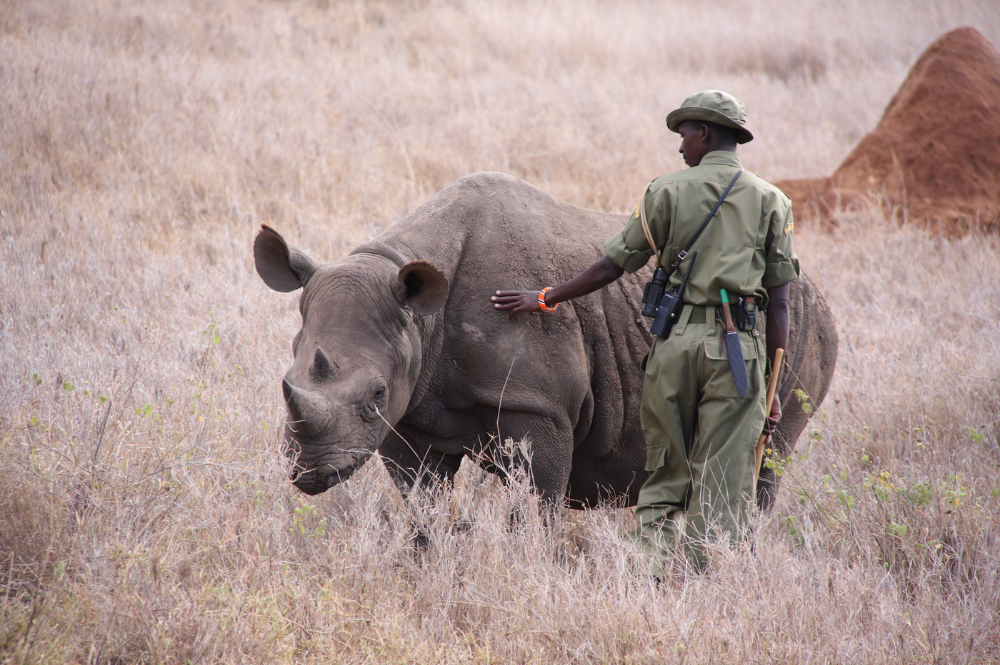In 1970, Kenya had an estimated 20,000 black rhinos, one of the largest national populations in Africa, with the mighty Tsavo ecosystem alone sheltering c.8,000. By the mid-1980s, numbers had plummeted to fewer than 400, dispersed in small populations across Kenya’s shrinking wilderness areas.
The decline was shocking and unprecedented, but, subsequently, rhino-bearing protected areas were reinforced, security improved and isolated rhinos translocated to new, intensively managed ‘rhino sanctuaries’. The result? A growing population heading in the right direction.
However, from the late 2000s, poaching cases began to increase. In 2013, ~8% of Kenya’s national population was illegally killed (59 animals) and poaching has continued– albeit at much, much lower levels – since.
Thankfully, the poaching rate has been low enough to enable Kenya’s rhino population to rise. In 2024, the country celebrated its Eastern black rhino population reaching more than 1,000 individuals, putting Kenya on the path to reach 2,000 individuals nationwide by 2037.
Despite the success to date, complacency is not an option when working to ensure the recovery of a Critically Endangered rhino species. One example of the work being done to support this has been Project UPTICK (Uniting Protection, Training and Intelligence in Central Kenya), funded by the US Government’s Bureau of International Narcotics and Law Enforcement Affairs (INL). A collaborative effort, Project UPTICK began in 2020, aiming to amplify security and enhance ranger training across rhino reserves.
Whilst the threat of poaching and other security issues such as cattle rustling were ongoing, there was another, less predictable threat: the COVID-19 pandemic. As lockdowns and travel restrictions were imposed, these last bastions of wilderness saw visitor numbers plunge and, with them, vital revenue streams. Wildlife conservation is, unfortunately, often funded on shoestring budgets and so this became a particularly challenging time. With this much-needed injection of funds, INL’s grant centred on the following activities being put into motion within the first two years:
- Increased efficiency in deployment of assets (e.g. rangers, vehicles, aircraft), reducing running costs and saving time
- A wide geographical area of rich biodiversity benefiting from the Joint Operation Command Centre (JOCC; the JOCC coordinates responses to all types of incidents in Laikipia-Meru, including poaching attempts, fence-line breaks, bushfires, and stock theft) and Kenya Wildlife Service oversight
- Increased morale and capacity of Anti-Poaching Units / National Police Reservists / Rapid Response teams and general security rangers, with the leadership skills vital to all three Conservancies’ security
- Rangers from all Conservancies being trained to the same standards and using the same protocols, so that they can be deployed to any of the sites in the event of an emergency
- Proactive training plans being developed to respond to needs, thus increasing site security assisting HR managers with identifying rangers suitable for leadership roles
- Conservancies’ efforts to interdict Level 1 poaching criminals being supported, while also enhancing coordination with government agencies in pursuing criminals working at Level 2 and 3 to receive, courier and facilitate illegal wildlife trade in Kenya
The continued efforts of rangers and conservation managers not only in the Laikipia-Meru landscape but across the country ensured that rhino populations were able to keep growing throughout 2020 and 2021. In 2022, thanks to a second INL grant, the Project was extended for an additional two years.
With the country’s rhino populations expanding, more and more secure landscapes will be needed to accommodate these animals as part of the Kenya Rhino Range Expansion initiative. The Laikipia-Meru landscape is one of just two places in the country with the potential to accommodate more than 750 rhinos, making it central to recovery efforts for the black rhino, not only in Kenya but Africa as a whole.
In September 2024, funding for the 4-year Project drew to a close. During the next two weeks, we will reflect on how this Project has impacted the security and integrity of Kenya’s protected areas, providing an example of what can be done to counter the poaching epidemic and put rhino populations – and indeed other species – on the road to recovery. Thanks to INL and other donors, we hope Kenya’s black rhino populations will remain on the uptick long into the future.
Project UPTICK Partners:
- Save the Rhino International, the grant applicant and overall Project Manager
- Ol Jogi Conservancy, a 58,000-acre conservancy that was established in 1980 and is located amidst striking scenery in Laikipia County
- Borana Conservancy, a 32,000-acre conservancy in Laikipia that borders Lewa Wildlife Conservancy. The Conservancy received its first black rhinos in 2013
- Lewa Wildlife Conservancy to the east in Meru County, a 62,000-acre expanse, which is part of a UNESCO World Heritage Site and, along with Borana, forms the contiguous Lewa-Borana Landscape
- Ol Pejeta Conservancy to the south. At 90,000 acres is the largest of the Project’s Conservancy Partners and is home to the last two known Northern white rhinos and the largest black rhino population in East Africa
- 51 Degrees Ltd. Formed in 2012, 51 Degrees Ltd has been a key training provider for the Conservancies’ rangers. Throughout this Project, the company has also been the entity liaising directly with the Kenya Wildlife Service, its parks and regional headquarters on the installation of hard- and software related to the implementation of EarthRanger™ and training courses for their rangers
- US Government’s Bureau of International Narcotics and Law Enforcement Affairs. Supporting programmes in more than 90 countries, INL’s purpose is to “keep Americans safe by countering crime, illegal drugs, and instability abroad”. One of its focal areas is tackling the illegal wildlife trade in respect of the End Wildlife Crime Act









